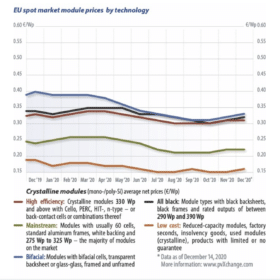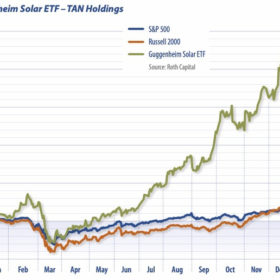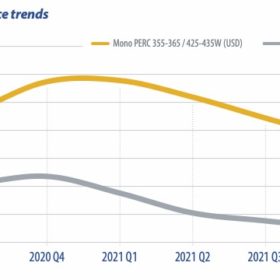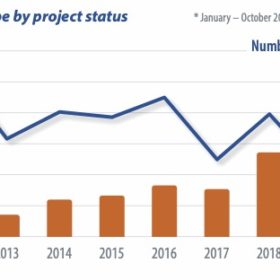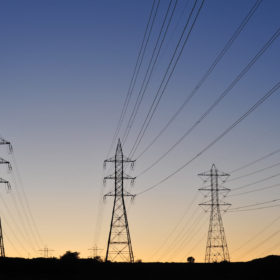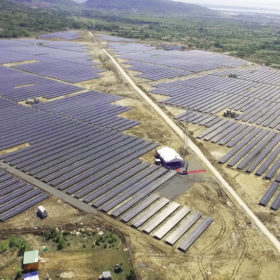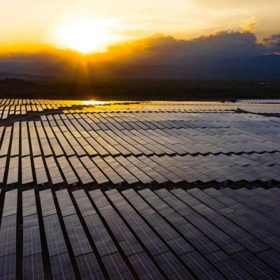The world won’t wait – Biden needs to catch up
The inauguration of Joe Biden as the 46th President of the United States has brought hope the country will play a central role in the world’s energy transition and combating climate change. However, rather than teaching other countries lessons, the U.S. will need to catch up with the rest of the world, and it needs to do so quickly – the world won’t wait for the U.S.
Module Price Index: 2020 – Taking the time to say ‘thanks’…
Alongside all of the problems, 2020 has brought us a few promising solar module manufacturer initiatives and developments. Martin Schachinger of pvXchange.com looks back over the second half of the year and offers a quick look at what could be in store for 2021.
Turkish PV manufacturer report reveals country’s annual production capacity is 5,610 MW/year
In September 2020, Stantec Turkey launched a market assessment report for the Turkish solar PV panel manufacturing sector. The English version of the “Market Report for Turkey’s Photovoltaic Panel Manufacturing” followed in November. The report, based on collected data from local manufacturers, depicts the history of the market since its inception in 2011 and provides unique insights into its development and future potential.
Guggenheim Solar Index: More to come in ‘21
With the wholesale transformation of the power industry from the inside out and other energy transition mega-trends, capital will continue to flow into renewables from ESG, energy funds, and retail, writes ROTH Capital Analyst Jesse Pichel. Look for a greater mix of unsubsidized economic solar projects to support improving revenue visibility, increasing earnings quality, and multiple expansions.
Solar set to shine in a post-pandemic world
The world is still combating Covid-19, with Europe now impacted by a second wave of the virus. While the market reported delays for a few projects, the impacts on the PV sector remain unclear. But if the world fails to curb the Covid-19’s spread, governments may be forced to reintroduce strict measures, thereby sapping PV demand. PV InfoLink’s Mars Chang expects module demand to hit 126 GW by the end of this year.
What is the UK government’s problem with solar?
You’ll need to pay close attention to find the few mentions of solar in the long-awaited White Paper issued by the government to outline how it plans to hit net zero by mid century.
Acquisition activity in Europe remains heated
The European solar market saw around 11 GW of projects, and pipelines change hands in 2019. The positive trend is expected to last, as investors remain optimistic about the future of the industry. Project acquisition activity is seen as a key indicator of financial health in many sectors, including the PV market. It reflects optimism among investors and points to a particularly high degree of liquidity, writes IHS Markit analyst Martina Assereto.
Boosting the energy transition: why the European Commission should support independent aggregators
Aggregators continuously monitor the needs of the electricity grid on one side and the energy consumption of a large number of distributed assets on the other. When the grid is stressed or out of balance, aggregators adjust the consumption or production of those distributed energy assets to help the grid restore balance. These services either lead to direct compensation from a transmission system operator (TSO), or a reduction in the total energy bill of the owner of the distributed asset.
The solar development process in Vietnam, its barriers and hurdles
The development process for ground-mounted utility scale solar projects in Vietnam is laborious, time-consuming, expensive and still largely difficult to navigate for foreign developers without entering a strategic partnership, in whatever form, with a local Vietnamese counterpart.
Why the solar M&A landscape in Vietnam is set to heat up
Vietnam has now effectively overtaken Thailand as the largest solar market in Southeast Asia in terms of installed solar operational capacity, with more than 6,314 MW installed up to September 2020. Many hundreds of MWs of solar projects are also still under construction or development. However, its solar (and other renewable energy) M&A activity has developed very slowly to date. There are many reasons to expect that this is about to change, but before we examine them, let us review the main factors behind this sluggish tempo.

